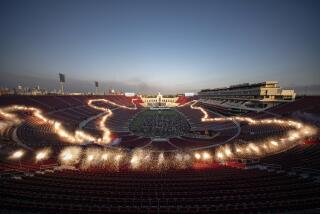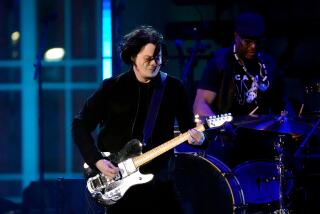Electric Daisy Carnival draws 185,000 for electronic music and good vibes
Surrounded by swirling, half-naked bodies and engulfed by waves of digital drum and bass, Latifa Hussan, 21, and her boyfriend, Cruz Rios, 22, were explaining what had made them drive down from Fresno at 6 a.m. for the Electric Daisy Carnival.
It wasn’t just the all-star lineup of DJs such as will.i.am, Kaskade and Deadmau5, or the Mardi Gras atmosphere at the electronic music festival, purportedly North America’s largest, which drew 185,000 people to the L.A. Memorial Coliseum and Exposition Park on Friday and Saturday.
It also was the way the festival “describes world peace in one small place,” Hussan said, “because here everyone gets along. That’s what’s so attractive.”
And with those thoughts, she and Rios drifted off into the crowds milling along a Coliseum pathway strung with Japanese lanterns and lined with fire-belching monumental metal sculptures.
Utopian sentiments have been part of modern music festivals since Woodstock was held on a bucolic upstate New York farm in 1969. But until relatively recently electronic music has had a hard time getting the media and the public to associate it with good vibrations.
When word of massive European dance-drug parties known as “raves,” fueled by the euphoria-inducing Ecstasy, first reached U.S. shores in the early 1990s, the reaction was as if a terrorist plot or the Black Plague had infiltrated North America.
Even one conservative Fox News commentator derided the resulting legislative and law enforcement crackdown on dance-music parties, culminating in the introduction of the so-called RAVE Act (Reducing Americans’ Vulnerability to Ecstasy Act ) in 2002 by then-U.S. Sen. (and now Vice President) Joe Biden, as an excessive response that would criminalize possession of glow sticks and bottled water.
Now in its 14th year, last weekend’s carnival went off fairly calmly, despite the disruptive efforts of some gate crashers who reportedly were quickly thwarted by the heavy LAPD and private security presence.
Pasquale Rotella, founder of Insomniac Events, the L.A.-based company that stages Electric Daisy Carnival, said Saturday night that the phenomenon of gate crashers at electronic music events was “something that’s very new.”
“It’s not part of the culture at all,” he said. “They [gate crashers] are not here for the music, and I don’t think they’re here for the event.”
Rotella recalled the days when electronic music culture was held at arm’s length.
“At first you couldn’t even get [the music] into clubs,” Rotella said. “At some point I thought to myself I didn’t know if it ever was going to be on this level.”
When he first staged his festival at the Shrine Auditorium in 1997, it drew only 5,000 people, Pasquale said.
Those days seemed distant Friday and Saturday, as throngs of teens and twenty- and thirtysomethings boogied and paraded before five massive stages in feathered headdresses, pastel ballet tutus, synthetic animal heads, black mesh body stockings, Venetian carnival masks, Hello Kitty knapsacks and furry boots.
Luis Chavez, 24, who’d come in from Riverside with his girlfriend and two other pals, was among the multitudes channeling the thumping one-world vibes.
“The sound of this music, it’s not California music, it’s not Chicago music, it’s not New York music, it’s not Asian music,” he said. “It’s global music.”
More to Read
The biggest entertainment stories
Get our big stories about Hollywood, film, television, music, arts, culture and more right in your inbox as soon as they publish.
You may occasionally receive promotional content from the Los Angeles Times.











